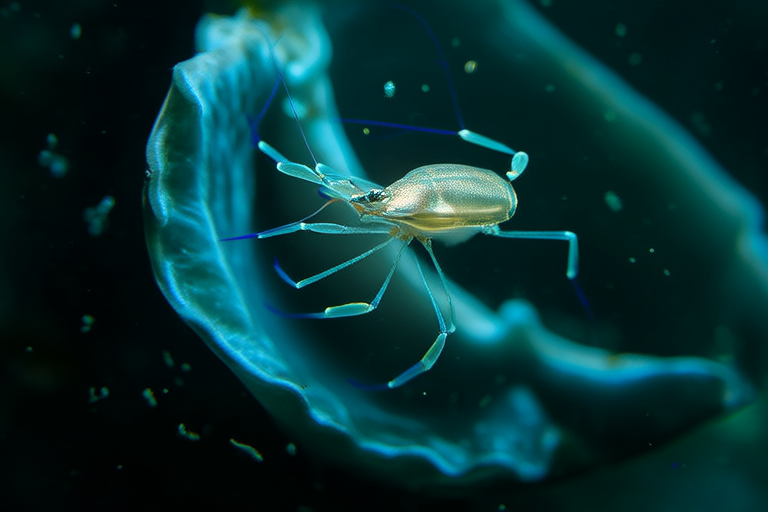Microscopic Marvels: Discovering the Pea Crab’s Secret World
In the vast ocean, where countless species thrive, there exists a world so small it is often overlooked. These tiny creatures, known as pea crabs, live in a realm of symbiosis, mystery, and adaptation. This article delves into the fascinating life cycle, habitat, and symbiotic relationships of pea crabs, offering a glimpse into their microscopic marvels.
The Unique Life Cycle of Pea Crabs
Pea crabs (Pinnotheridae) are a family of tiny crustaceans that lead an intriguing life cycle. Their existence begins in the planktonic stage, where they drift in the open waters, feeding on microscopic organisms. Once they reach a certain size, they seek out a suitable host to establish a lifelong relationship. The transition from a free-swimming larva to a fully grown adult is marked by a series of molts, during which the crab sheds its exoskeleton to grow. Unlike most crabs, pea crabs never leave their host once they have found one, making their lives highly dependent on the environment provided by their chosen partner.
Habitats and Hosts
Pea crabs can be found in various aquatic environments, including salt marshes, estuaries, and coastal waters. They are particularly drawn to mollusks such as clams, oysters, mussels, and even sea cucumbers. These mollusks serve as both a home and a food source for the pea crabs, providing them with shelter and nutrients. The choice of host is crucial, as it determines the crab’s survival and reproductive success. For instance, some species of pea crabs preferentially inhabit bivalve mollusks like oysters, while others may opt for gastropods or echinoderms. The specificity of these relationships underscores the importance of niche selection in the crab’s lifecycle.
Symbiotic Relationships
The symbiotic relationship between pea crabs and their hosts is a classic example of mutualism, where both parties benefit. The pea crabs gain protection and sustenance from their hosts, while the hosts, in turn, receive protection from predators and parasites. In some cases, the presence of pea crabs has been shown to improve the health and growth rates of their hosts. This mutually beneficial arrangement highlights the intricate web of life within marine ecosystems, demonstrating how even the smallest organisms play significant roles in maintaining balance.
Fascinating Facts About Pea Crabs
One of the most striking features of pea crabs is their diminutive size. Adults typically range from just a few millimeters to several centimeters in length, making them among the smallest members of the crab family. Despite their petite stature, they possess all the characteristic features of larger crabs, including claws, legs, and a hard exoskeleton. Their coloration varies depending on the species and host, often blending seamlessly with the interior of their chosen home. This camouflage helps protect them from potential threats and enhances their ability to remain undetected.
The diet of pea crabs is another aspect that sets them apart from other crustaceans. While many crabs are carnivorous, pea crabs are omnivores, feeding on a variety of organic matter found within their host. They consume detritus, bacteria, and other microorganisms, as well as the host’s own tissues. This diverse diet allows them to thrive in environments where food sources might otherwise be scarce. Additionally, their small size enables them to exploit resources that larger predators cannot access, further enhancing their survival strategies.
Adaptations for Survival
To survive in their specialized habitats, pea crabs have evolved a range of remarkable adaptations. One of the most notable is their flattened body shape, which allows them to fit snugly inside the shells of their hosts. This adaptation not only provides protection but also facilitates movement within the confined spaces of bivalves. Furthermore, their flexible legs enable them to navigate through narrow crevices and grasp onto surfaces securely. These physical traits contribute to their ability to maintain a stable position within their hosts and avoid being dislodged.
Beyond their physical attributes, pea crabs exhibit behavioral adaptations that enhance their symbiotic relationships. For example, they have been observed grooming their hosts, which may help remove harmful parasites and promote overall health. This behavior demonstrates the extent to which these crabs are integrated into the lives of their partners, illustrating the depth of their mutual dependence.
Ecological Significance
The ecological significance of pea crabs extends beyond their direct interactions with hosts. By influencing the health and survival of their hosts, pea crabs indirectly impact the broader marine ecosystem. Healthy bivalve populations, for instance, play a vital role in water filtration and nutrient cycling, processes that are essential for maintaining the productivity and biodiversity of coastal habitats. Therefore, the presence of pea crabs can have far-reaching consequences for the entire ecosystem, highlighting the interconnectedness of marine life.
Moreover, the study of pea crabs offers valuable insights into the principles of symbiosis and adaptation. Scientists can use these insights to better understand how organisms coexist and evolve within complex ecosystems. This knowledge has practical applications in fields such as aquaculture, where understanding the dynamics between hosts and symbionts can inform sustainable practices and improve yields.
Conclusion
Pea crabs are more than just tiny crustaceans; they are ambassadors of the microscopic world, showcasing the wonders of symbiosis and adaptation. Their unique life cycle, habitat preferences, and symbiotic relationships paint a picture of a complex and interdependent ecosystem. By exploring the secret world of pea crabs, we gain a deeper appreciation for the intricate balance that governs life in the oceans. Whether you’re a seasoned marine biologist or simply curious about the natural world, the story of pea crabs offers a captivating glimpse into the hidden marvels of our planet’s waters.
